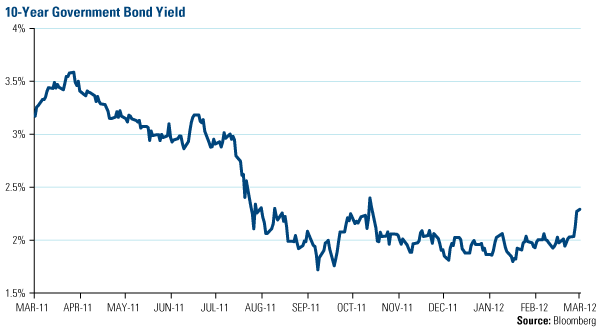The Economy and Bond Market Radar (March 19, 2012)
The yield on the 10-Year U.S. Treasury note registered the biggest weekly advance since July 1, in response to buoyant February employment data coupled with an absence of a strong signal of further quantitative easing from the Fed meeting on Tuesday. The chart below shows the 10-Year yield broke out of its trading range, oscillating around 2 percent since November. The “risk on” trade was reinforced this week.
The Fed raised its economic growth outlook to “moderate” from “modest,” in view of the continuation of positive economic data, especially on the employment front. The Fed described recent increases in oil and gasoline prices as “temporary,” and kept its verbiage unchanged for an “exceptionally low” fed funds rate “at least through late 2014.”

Strengths
- Three years of rising employment finally led to the first increase, albeit small, in consumer debt in the U.S. since the second quarter of 2008. U.S. household debt rose 0.3 percent in the fourth quarter of 2011, following 13 consecutive quarters of decline.
- Despite a 6 percent increase in gasoline prices in February, headline Consumer Price Index (CPI) in the U.S. rose only 0.4 percent month-over-month and 2.9 percent year-over-year, in line with expectations, thanks to tame pricing changes in non-energy items.
- India’s industrial production expanded by a higher than expected 6.8 percent in January from a year earlier, led by a surge in the food products and beverages category.
Weaknesses
- U.S. industrial production was little changed month-over-month in February, lower than expected and decelerating from December and January, due to a decline in mining activity and flat output from utilities related to warm weather.
- In January, U.S. new orders of non-defense capital goods excluding aircraft posted the first annualized decline since the second quarter of 2009.
- Chinese exports in January and February combined grew 7 percent year-over-year, decelerating from 13.4 percent in December and 20.3 percent in the entire 2011, driven primarily by slowing shipments to Europe.
Opportunities
- Should a growth scare resurface due to a lack of announcement of further quantitative easing from the Fed, bonds may rally again as investors flee to safety. This scenario happened in mid-2010 and mid-2011 when QE1 and QE2 programs ended.
Threats
- Rising oil and gasoline prices combined with liquidity implications of global easing led by Europe, may raise the prospect of the reappearance of higher inflation going forward. An increasing number of Asian central banks decided to leave rates on hold after recent cuts.











